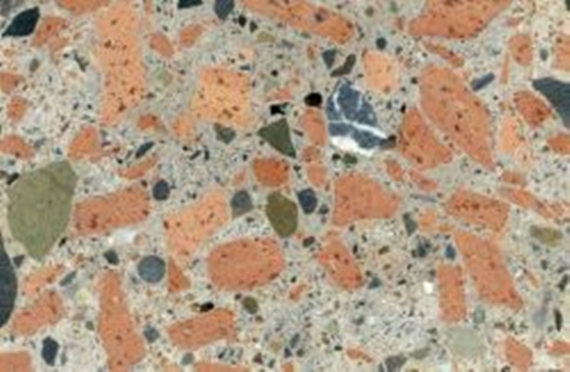Recycling Concrete
In Switzerland 68 million tons of building materials are consumed per year. 90% of it originates from primary sources. The amount of waste generated by demolition of building is about 13 million tons per year. Models indicate that this amount will increase by nearly 10% by the year 2010. Concrete and mixed rubble are a major component of such waste. The recycling of concrete and mixed rubble for the use as concrete aggregate is an important way for the concrete industry to contribute to a sustainable material flow. The volume of disposed material can be reduced and the natural resources of sand and gravel are conserved.

Beton mit Recyclingzuschlag - ästhetisch und nachhaltig
Consequently there is a great need of research regarding material properties as well as structural behavior of recycling concrete. Therefore, our research focuses on the characterization of recycled materials and the influence of the varying composition on concrete properties. Furthermore, the behavior in structures is investigated. Based on the result, potential application in structures are identified.
Our research projects:
In these projects the characteristic properties of the recycled aggregates are investigated and their influence on the fresh and hardened concrete properties are shown as well.
- recycling concrete produced with recycled concrete aggregates
- mixed rubble aggregates
Important publications and documents:
- Leemann, A., & Loser, R. (2019). Carbonation resistance of recycled aggregate concrete. Construction and Building Materials, 204, 335-341.
- Hoffmann, C., Schubert, S., Leemann, A., Motavalli, M. (2012) Recycled concrete and mixed rubble as aggregates: influence of variations in composition on the concrete properties and their use as structural material. Construction and Building Materials 2012, 35, 701-709
- Schubert, S., Hoffmann, C., Leemann, A., Moser, K., Motavalli, M. (2012) Recycled aggregate concrete: Experimental shear resistance of slabs without shear reinforcement, Engineering Structures, 41 ,490-497
- Hoffmann, C. (2010). Recyclingbeton mit Mischgranulat. Eigenschaften der Recycling-Gesteinskörnung und Einfluss auf die Festbetoneigenschaften. Umwelt-Perspektiven, 6(4), 52-55
- Hoffmann, C./Leemann, A. Recycled concrete and mixed rubble as aggregates: influence of variations in composition on the concrete properties. Sustainable Construction materials and Technologies, Coventry, UK, June 11-13. 2007, 60-72. /C
- Hoffmann, C./Jacobs, F. Überblick über Regelungen zu Beton mit rezyklierter Gesteinskörnung. 2010 Ernst & Sohn Verlag für Architektur und technische Wissenschaften GmbH & Co. KG, Berlin · Beton- und Stahlbetonbau 105 (2010), Heft 12
- Hoffmann, C. (2005). Recyclingbeton zwischen Ökologie und Qualität. Tec21, 131(3-4), 24-27
Research results: Collaboration with Cemsuisse
- Grundlagen für die Verwendung von Recyclingbeton mit Mischgranulat
- 201405: Karbonatisierungswiderstand von Recyclingbeton
- 201207: Zusammenhang zwischen Karbonatisierungswiderstand, CO2-Pufferkapazität und Diffusivität von Mischzementen
- 201701: Validierung des Sulfatwiderstandes nach SIA 262/1 Anhang L

-
Share
